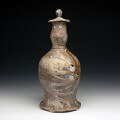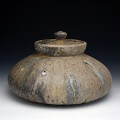
Red Lodge Clay Center Short-Term Resident (AIA) 2015, (AIA) 2017, (AIA) 2024
Martin Tagseth received his first formal art education in Alberta, earning a Fine Art Diploma from Red Deer College in 1989. He then traveled to Halifax, where he earned a Bachelor of Fine Arts from the Nova Scotia College of Art and Design in 1991. Tagseth’s studies next took him to Norway’s Insstitutt Keramisk Kunndsthandervk, and finally to Ohio State University, where he received his Master of Fine Arts in 1994. Since, Tagseth has been teaching and leading workshops at various institutions in Canada and the United States, including the University of Alaska, the University of Manitoba, the Emily Carr College of Art and Design, the Hartford School of Art (Connecticut), West Virginia University, Jindezhen (China) and Montana State University in Bozeman.
Tagseth is currently an adjunct professor at the University of Regina, a position he began in 2008. Tagseth’s pottery is influenced by his western Canadian agrarian upbringing and the ceramic traditions of 17th Century Korea and China. Making use of wood-firing, salt-firing, and applied glaze chemistry, Martin’s works are conceptual, though they involve traditional vessel forms. Tagseth writes: “It is not my intent to consciously direct the viewer toward a specific aesthetic, but to simply present them with what I consider to be traditional, yet visually poetic objects that may alter the way in which they view ceramics as a whole….The forms used throughout are both historically & culturally significant, and are intended to be recognizable as such. By altering the scale, proportion, surface considerations and the spaces the works inhabit, the resulting ceramic pieces are seen in constructed or fabricated context, and provide the viewer with a new reading on the object’s tradition.”
The studio research I am presently engaged in could be viewed as an examination of the indicators of utility, and their formal significance to our contemporary understanding of ceramic form. It is not my intent to consciously direct the viewer toward a specific aesthetic, but to simply present them with what I consider to be poetic objects that may alter the way in which they view ceramics as a whole.
The main body of my current work is concerned with the manipulation of the specific elements that primarily dictate function. The forms used throughout all areas of my current work are both historically & culturally significant, and are intended to be recognizable as such. By altering the scale, proportion, surface considerations and the spaces the works inhabit, the resulting ceramic pieces are seen in constructed or fabricated context, and provide the viewer with a new reading on the object’s tradition.
Numerous ideas actively influence the manner in which I address these predominantly ceramic works. Of primary relevance are those that arise from my personal western Canadian heritage, and the ceramic traditions of 17th Century Korea, Japan and China. The relationship between storage/architecture, and the notion of decoration/surface are also points of departure that contribute to ideas associated with an objects’ purpose.
My continued research into the chemistry of ceramic materials in combination with wood firing has introduced the element of chance into this evolving tradition. The use of fire as an expressive tool provides the work with something unattainable with intellect alone. Fire is the elusive element that gives rise to a conscious awareness of the crucial role of chance within the work, and that it may in the end be the only governor of the work’s ultimate success or failure.






